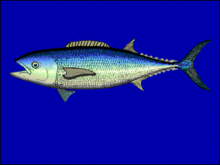Butterfly kingfish
| Butterfly kingfish | |
|---|---|
 | |
| Scientific classification | |
| Kingdom: | Animalia |
| Phylum: | Chordata |
| Class: | Actinopterygii |
| Order: | Perciformes |
| Family: | Scombridae |
| Subfamily: | Gasterochismatinae Lahille, 1903 |
| Genus: | Gasterochisma Richardson, 1845 |
| Species: | G. melampus |
| Binomial name | |
| Gasterochisma melampus Richardson, 1845 | |
| Synonyms | |
| |
The butterfly kingfish (Gasterochisma melampus) is an ocean-dwelling ray-finned bony fish in the mackerel family, Scombridae – a family which it shares with the tunas, mackerels, Spanish mackerels, and bonitos. Unlike the 50 species from those four tribes, however, this species is unique in that it is the only scombrid to be classified apart from the rest, into the subfamily Gasterochismatinae and genus Gasterochisma.[2][3][4]
Although taxonomists and the Food and Agriculture Organization of the United Nations have accepted the name "butterfly kingfish", this fish has had many common names, including big-scaled mackerel, bigscale mackerel, butterfly mackerel, butterfly tuna, scaled tunny, scaly tuna, and others. In 1993, the U.S. Food and Drug Administration gave approval for this fish to be marketed simply as "mackerel".[5]
Description
The juveniles of the butterfly kingfish are characterized by enormous pelvic fins that are longer than the length of its head, and that become more proportional as the fish grows. At any size, the pelvic fin tucks into a deep ventral groove, in much the same way as the first dorsal spines do in all scombrids. This species has very large cycloid scales, below which is a thick layer of fat. The swim bladder has two anterior projections that extend into the back of the skull, near the inner ear.[6] This fish lacks the median keel on the caudal peduncle – it only has the characteristic pair of small keels on each side of the base of the caudal fin, as do other scombrids. It has 21 precaudal vertebrae, plus 23 caudal vertebrae.[4]
.gif)
This fish can be found around the world in southern temperate waters of 8–15 °C (46–59 °F), but most commonly under 10 °C (50 °F), and at depths to 200 m (660 ft) in the open ocean. It grows to a length of 1.64 m (5.4 ft).[7]
Most bony fishes are ectothermic, or cold-blooded, but this species, much like the related tunas, is endothermic and is able to raise its body temperature to achieve a degree of thermoregulation.[8] It has a brain heater organ derived from the lateral rectus eye muscle, which is distinct from that of the billfishes, whose heater is derived from their superior rectus muscles.[4]
Etymology
Gasterochisma derives from the Ancient Greek: γαστήρ (gaster) "stomach", and χίασμα (chiasma) "crossing; X-shaped; sign of the 'X'".[7]
Taxonomy
The evolutionary lineage of the butterfly kingfish is more primitive and quite different from that of the rest of the scombrids. Additionally, the morphology of this species is substantially different from that of the others – some suggest that it might belong in a different family altogether.[6] At present, however, morphology and nuclear phylogeny provide support that Gasterochisma is the basal scombrid, and that both its genus, Gasterochisma, and its subfamily, Gasterochismatinae, remain as monotypic taxa under the family Scombridae.[4]
The following cladogram shows the most likely evolutionary relationships between the butterfly kingfish and the tunas, mackerels, Spanish mackerels, and bonitos.
| Butterfly kingfish, in the family Scombridae | |||||||||||||||||||||||||||||||||||||||||||||||||||||||||||||||||||||||||||||||||||||||||||||
| |||||||||||||||||||||||||||||||||||||||||||||||||||||||||||||||||||||||||||||||||||||||||||||
| Cladogram: With 51 different species in the Scombridae family, the butterfly kingfish sits apart from the rest – it is the only scombrid species that does not belong to the Scombrinae subfamily.[2][4] |
| Wikimedia Commons has media related to Gasterochisma melampus. |
| Wikispecies has information related to: Gasterochisma melampus |
References
- Gasterochisma melampus. Richardson, 1845 . Retrieved through: World Register of Marine Species.
- Tony Ayling & Geoffrey Cox, Collins Guide to the Sea Fishes of New Zealand, (William Collins Publishers Ltd., Auckland, New Zealand 1982) ISBN 0-00-216987-8
- ↑ Collette, B.; Boustany, A.; Carpenter, K.E.; Di Natale, A.; Fox, W.; Graves, J.; Juan Jorda, M.; Miyabe, N.; Nelson, R.; Oxenford, H.; et al. (2011). "Gasterochisma melampus". IUCN Red List of Threatened Species. Version 2012.2. International Union for Conservation of Nature. Retrieved 22 October 2012.
- 1 2 Graham, Jeffrey B.; Dickson, Kathryn A. (2004). "Tuna Comparative Physiology" (PDF). The Journal of Experimental Biology. 207: 4015–4024. doi:10.1242/jeb.01267. Retrieved 20 September 2012.
- ↑ "Gasterochisma melampus". Integrated Taxonomic Information System. Retrieved 18 April 2006.
- 1 2 3 4 5 Orrell, T.M.; Collette, B.B; Johnson, G.D. (2006). "Molecular data support separate Scombroid and Xiphioid Clades" (PDF). Bulletin of Marine Science. 79 (3): 505–519. Retrieved 28 October 2012.
- ↑ Randolph, S.; Snyder, M. The seafood list: FDA's guide to acceptable market names for seafood sold in interstate commerce. Washington, D.C.: U.S. Government Printing Office.
- 1 2 Collette, Bruce B.; Reeb, Carol; Block, Barbara A. (2001). "Chapter 1: Systematics of the Tunas and Mackerels (scombridae)". In Block, Barbara A.; Stevens, E. Donald. Tuna: physiology, ecology, and evolution; Volume 19 of Fish Physiology. San Diego, Calif.: Academic Press. p. 5. ISBN 9780123504432.
- 1 2 Froese, Rainer and Pauly, Daniel, eds. (2012). "Gasterochisma melampus" in FishBase. October 2012 version.
- ↑ Block, B.A.; Finnerty, J.R. (1993). "Endothermy in fishes: a phylogenetic analysis of constraints, predispositions, and selection pressures" (PDF). Environmental Biology of Fishes. 40 (3): 283–302. doi:10.1007/BF00002518.
